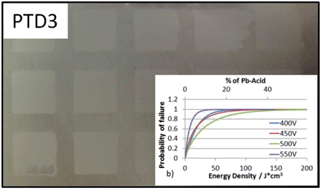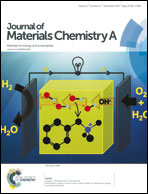Photonic curing of aromatic thiol–ene click dielectric capacitors via inkjet printing
Abstract
Dielectric capacitive energy storage has a wide range of applications such as microelectronic devices, grid scale load leveling, military applications, and personal power supplies. The high charge and discharge rate, along with the high retention and fatigue properties, make dielectric capacitors an attractive means of energy storage. Device manufacturing in industry requires high throughput and high pattern registry printing processes, such as inkjet, that are able to deposit a wide variety of materials. Thiol–alkene systems, [pentaerythritol tetrakis(3-meracproprinate) (PEMP, P), 1,3-diisopropenylbenzene (DPB, D), 2,4,6-triallyoxy-1,3,5-triazine (TOTZ, T)] of various compositions were printed via inkjet printing and cured with a xenon flash lamp system. For simplicity, inks were designated PTD0–4, correlating to the amount of DPB in the ink. PTD1–4 demonstrated fluid properties amenable to inkjet printing (with Z factors between 2–11) and were cured to produce mechanically and chemically stable dielectric films. PTD3 showed the best printability and was used for characterization of energy storage. It was found that the dielectric constant varied with curing intensity and energy/voltage. The breakdown strength had no correlation to the curing parameters tested. Weibull analysis of breakdown failure along with dielectric characterization resulted in a volumetric energy density distribution with a peak characteristic energy storage (63% chance of failure) of 32 J cm−3.


 Please wait while we load your content...
Please wait while we load your content...